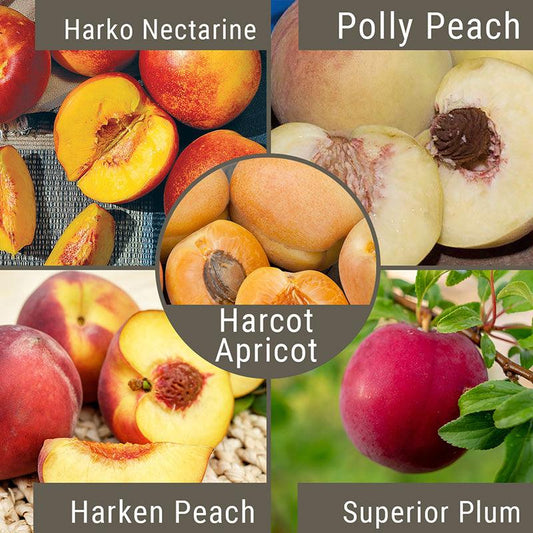Fruit Tree Spacing Guide for High Density Fruit Tree Planting & Pruning
High density fruit tree planting has changed the way both beginners and seasoned home growers design orchards. Instead of planting large trees far apart, this method focuses on high density fruit tree spacing, using semi-dwarf rootstocks, close tree spacing, and careful pruning to produce more fruit in the same allotted space.
Whether you’re working with a small backyard, side yard, or urban lot, high density planting allows you to grow more varieties and improve fruit quality without sacrificing manageability.
What Is High Density Planting?
High density planting is a modern orchard system where trees can be planted far closer than traditional layouts—often only 3–5 feet apart, or even closer in espalier or multi-tree plantings.
This technique originated in commercial orchards to increase yield per acre, but home growers now use it to maximize fruit production in small spaces.
High density orchard planting typically uses:
- Semi dwarf trees and other smaller trees
- Dwarfing or semi dwarf rootstocks to limit tree height
- Training systems like the central leader or tall spindle
- Summer pruning to control vegetative growth
- Support systems such as a wire trellis
- Strategic fruit tree spacing for airflow and light
For a deeper look at fruit-tree basics, explore the Fruit Trees Resource Center.

Why Choose High Density Fruit Tree Spacing?
Grow More Fruit in Less Space
By planting fruit trees close together, you can grow multiple varieties where one large tree would normally stand. This boosts pollination and increases fruit production.
Earlier Harvests
Density orchards often begin producing fruit sooner—sometimes within the first 2–3 years—because smaller trees put more energy into fruiting.
Better Fruit Quality
Smaller trees allow better sunlight penetration, improving sweetness, color, and airflow.
Easier Care
High density trees are kept small, so pruning, spraying, hand thinning, and harvesting stay easy and ladder-free.

Choosing the Right Trees for a High Density Orchard
Rootstock & Variety Selection
The success of density planting starts with rootstock. Semi dwarf rootstocks strike the perfect balance between vigor and compact size. Browse well-suited options in the Dwarf & Semi-Dwarf Tree Collection.
Some varieties naturally stay compact, such as the NSJ Old Peach—a great choice for tight spaces.
Start With Healthy Soil
Strong roots need healthy soil. Begin with a test from the Soil Testing Collection, then amend as needed with organic nutrients from the Soil Amendments Collection.
For a wide selection of high-quality bare root trees ideal for high density systems, see the Bareroot Trees Collection.
You can also check chill hour requirements using the Fruit Tree Chill Hours Guide.
How Far Apart to Plant Fruit Trees in a High Density System
Spacing depends on your training system:
- Tall spindle or central leader: 3–5 feet between trees
- Espalier: 18 inches–3 feet
- 3–4 trees in one hole: 18–24 inches apart
- Rows spaced 10–12 feet apart for airflow
These tight spacing strategies help manage tree height and maintain excellent fruit quality.
Training & Support for High Density Tree Planting
The Central Leader System
A single trunk trained upward with evenly spaced branches. This is ideal for apples and pears in high density orchards. Learn more about training styles in Choosing Training Shapes for Fruit Trees.
Espalier
Perfect for fences or narrow beds. Trees are trained flat against a wall or wire trellis. Explore support options in the Plant Support & Trellis Collection.

Pruning for High Density Orchard Planting
Dormant Pruning
This shapes your framework and removes weak or damaged wood. Learn why starting with short trees creates stronger structure in Pruning Young Fruit Trees: Why Shorter Is Better.
Summer Pruning
Summer pruning helps keep trees compact and limits vegetative growth—critical for high density tree planting. Read more in Reasons for Summer Pruning Fruit Trees.
For pruning specific species like cherry, apricot, plum, walnut, and persimmon, see How to Prune Stone Fruit & Nut Trees.
Tools
Find high-quality pruning shears, saws, and loppers in the Orchard Pruning Tools Collection, and keep them sharp using the Tool Sharpeners Collection.
Companion Planting & Fruit Thinning
Companion plants support pollinators and reduce pests. Learn strategies in the Companion Planting Video Guide.
Summer thinning boosts fruit size and prevents stress in high density systems:
Conclusion
High density planting makes it possible to grow a “fruit salad orchard” even in limited space. With thoughtful fruit tree spacing, structured training, and consistent pruning, your trees stay small, productive, and easy to manage.
Explore more fruit-growing inspiration in the Fruit & Nut Trees Collection or consider a guide like Grow a Little Fruit Tree to deepen your knowledge.









6 comments
Thanks for an interesting read.
Frank, the first year in the ground you can just allow the branches to grow. This will allow the trees to get a good root system established. If there is a smaller weaker tree, put that on the south facing location, so it does not get shaded out by the more aggressive larger trees. The second year you can start to prune out the branches that are growing toward the center and make sure you keep the larger, faster growing trees pruned as to not overgrow the smaller trees.
I planted a number of root stock fruit trees, three in the same hole and pruned to knee height. They are now starting to bud. Should I remove the buds that are inward facing or wait until there are branches that I can prune?
Navamany, that is really hard to say how long it will take for production of fruit. I would think a couple of seasons, but it will also depend on the type of tree you pruned.
How long it will take for high density fruit tree to produce fruits, specially after heading cut